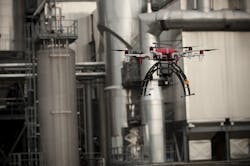If you saw the cover of Automation World’s May issue, you might have the overwhelming sense that drones will soon be filling our skies. Hyperbole aside, though, the drones are indeed coming—not just for taking cool videos in hard-to-reach places, but also for industrial applications such as outdoor inspections.
Now the U.S. Federal Aviation Administration (FAA) has removed a key barrier for drones (or unmanned aircraft systems) to be used in commercial industry. New rules have gone into effect that should make it easier for manufacturers to develop drone applications.
Concerned about how the growth of commercial applications is likely to fill our airspace with unmanned aircrafts, the FAA has been the biggest obstacle to industrial drone adoption. One key impediment has been the FAA’s requirement that drone operators be licensed pilots, a pretty high barrier to entry.
The new rule, called Part 107, is designed to make it easier to use drone technology for innovative applications. “People are captivated by the limitless possibilities unmanned aircraft offer, and they are already creating business opportunities in this exciting new field,” said Anthony Foxx, transportation secretary, in a statement along with the release of the new regulations. “These new rules are our latest step toward transforming aviation and society with this technology in very profound ways.”
Industry estimates predict the new rule to generate more than $82 billion for the U.S. economy and create more than 100,000 new jobs over the next 10 years, according to DroneDeploy, pointing to what it expects will be the unleashing of pent-up demand for drone services.
“We had already seen remarkable growth in the commercial drone industry the last few months, and before the Part 107 implementation, the amount of data generated by our users had been doubling every four months,” said Mike Winn, co-founder and CEO of DroneDeploy. “For example, among the newer industries to adopt drones, mining, inspection and oil and gas have been our fastest-growing sectors.”
DroneDeploy recently hit a milestone of its customers mapping more than 5 million acres across 130 countries, and Part 107 should help that business grow even faster. “Part 107 is the rule many businesses have been waiting for, before beginning to explore or investing further in drone operations,” Winn said. “Not only does Part 107 reduce the previous barriers to starting a commercial drone operation, it also makes it easier for large enterprises to scale their drone activities with more pilots, more efficient use of personnel and fewer regulatory hurdles.”
The rules are still relatively restrictive, geared toward minimizing risks to other aircraft as well as people and property on the ground. Under Part 107, a drone pilot must still maintain visual line of sight; a drone must stay close enough to the operator at all times for him to be able to see the drone without visual aids (other than corrective lenses). Drones may not be operated over people not directly participating in the flying of the aircraft, and they also cannot be operated in a covered structure. Also, only daylight operations are allowed.
“The FAA’s role is to set a flexible framework of safety without impeding innovation,” said Michael Huerta, FAA administrator. “With these rules, we have created an environment in which emerging technology can be rapidly introduced while protecting the safety of the world’s busiest, most complex airspace.”
The new rules will likely still make it difficult for manufacturing operations to adopt drone inspection techniques other than outdoor inspections such as oil and gas pipes or shipping yards. But the FAA has also made it easier to get around some of the rules; users can apply for waivers as long as they can show that the aircraft will still be operated safely. The FAA issued more than 70 waivers Sept. 1, the majority of which were for night operation under Part 107.
Leaders relevant to this article:

